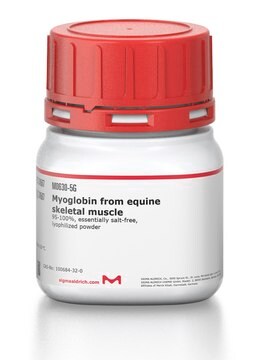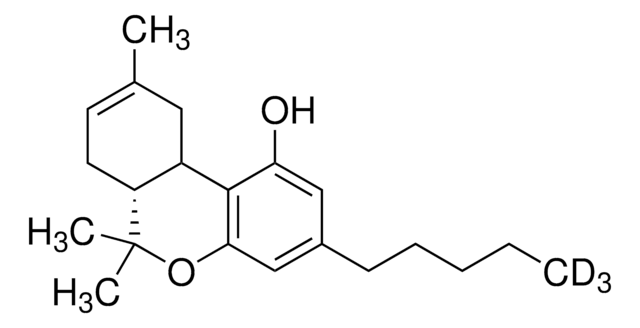C-046
Cannabinol solution
1.0 mg/mL in methanol, ampule of 1 mL, certified reference material, Cerilliant®
About This Item
Produtos recomendados
grau
certified reference material
forma
liquid
Características
SNAP-N-SPIKE®, SNAP-N-SHOOT®
embalagem
ampule of 1 mL
fabricante/nome comercial
Cerilliant®
concentração
1.0 mg/mL in methanol
técnica(s)
gas chromatography (GC): suitable
liquid chromatography (LC): suitable
aplicação(ões)
cannabis testing
cannabis testing
formato
single component solution
temperatura de armazenamento
−20°C
cadeia de caracteres SMILES
CCCCCc1cc(O)c-2c(OC(C)(C)c3ccc(C)cc-23)c1
InChI
1S/C21H26O2/c1-5-6-7-8-15-12-18(22)20-16-11-14(2)9-10-17(16)21(3,4)23-19(20)13-15/h9-13,22H,5-8H2,1-4H3
chave InChI
VBGLYOIFKLUMQG-UHFFFAOYSA-N
Procurando produtos similares? Visita Guia de comparação de produtos
Categorias relacionadas
Descrição geral
Cannabinol is a phytocannabinoid that belongs to the class of C21 terpenophenolic compounds. Found in the cannabis plant it is a metabolite of Δ9-THC, the main psychoactive component of cannabis. Cannabinol is also the primary product of THC degradation from exposure to air and light.
Aplicação
- Estimation of four cannabinoids from an oil matrix using reversed-phase high-performance liquid chromatography (RP-HPLC) combined with a diode array detector (DAD)
- Simultaneous analysis of 11 cannabinoids in biomass and extracts of different cannabis varieties by an HPLC-UV method, following the International Conference on Harmonization (ICH) Tripartite Guideline for Validation of Analytical Procedures
- Determination of eight cannabinoids in eight hemp samples and 12 forensic cannabis samples using reversed phase-high-pressure liquid chromatography (RP-HPLC) in combination with UV detector
- Analysis of dried marijuana flowers to measure the amount of nine cannabinoids by high-performance liquid chromatography (HPLC) along with UV detection
- Development and validation of an ultra high-performance liquid chromatographic (UHPLC) method coupled to photodiode array and mass spectrometry detectors to determine 11 cannabinoids in various Cannabis Sativa samples
- Quantitative analysis of 17 cannabinoids in cannabis and hemp samples by LC-MS/MS following their liquid-solid extraction following AOAC and ASTM guidelines for cannabis and hemp matrices
Características e benefícios
- Fully characterized under ISO/IEC 17025 and ISO 17034 accreditation
- Accompanied with a comprehensive Certificate of Analysis (CoA) with data on stability, homogeneity, accuracy of concentration, uncertainty, and traceability
- Rigorously tested through real-time stability studies to ensure accuracy and shelf life
- Gravimetrically prepared using qualified precision balances to ensure minimal uncertainty
- Flame sealed under argon into ampoules for long-term shelf life
- Offered in a convenient, DEA-exempt format to improve laboratory efficiency
Informações legais
produto relacionado
Palavra indicadora
Danger
Frases de perigo
Declarações de precaução
Classificações de perigo
Acute Tox. 3 Dermal - Acute Tox. 3 Inhalation - Acute Tox. 3 Oral - Flam. Liq. 2 - STOT SE 1
Órgãos-alvo
Eyes,Central nervous system
Código de classe de armazenamento
3 - Flammable liquids
Classe de risco de água (WGK)
WGK 2
Ponto de fulgor (°F)
49.5 °F - closed cup
Ponto de fulgor (°C)
9.7 °C - closed cup
Certificados de análise (COA)
Busque Certificados de análise (COA) digitando o Número do Lote do produto. Os números de lote e remessa podem ser encontrados no rótulo de um produto após a palavra “Lot” ou “Batch”.
Já possui este produto?
Encontre a documentação dos produtos que você adquiriu recentemente na biblioteca de documentos.
Artigos
The cannabinoids found in the Cannabis plant commonly referred to as marijuana, have grown in popularity for treating a variety of ailments from arthritis, glaucoma, and chronic pain to malnutrition, multiple sclerosis, and cancer.
Tetrahydrocannabinolic acid A solution, 1.0 mg/mL in acetonitrile, ampule of 1 mL, certified reference material.
Protocolos
Tetrahydrocannabinolic acid A solution, 1.0 mg/mL in acetonitrile, ampule of 1 mL, certified reference material; Cannabichromenic Acid (CBCA) solution, 1.0 mg/mL in acetonitrile, certified reference material, ampule of 1 mL
HPLC separation of 17 important cannabinoids including CBD, delta 9 THC and THCA. Read the application note
Nossa equipe de cientistas tem experiência em todas as áreas de pesquisa, incluindo Life Sciences, ciência de materiais, síntese química, cromatografia, química analítica e muitas outras.
Entre em contato com a assistência técnica











